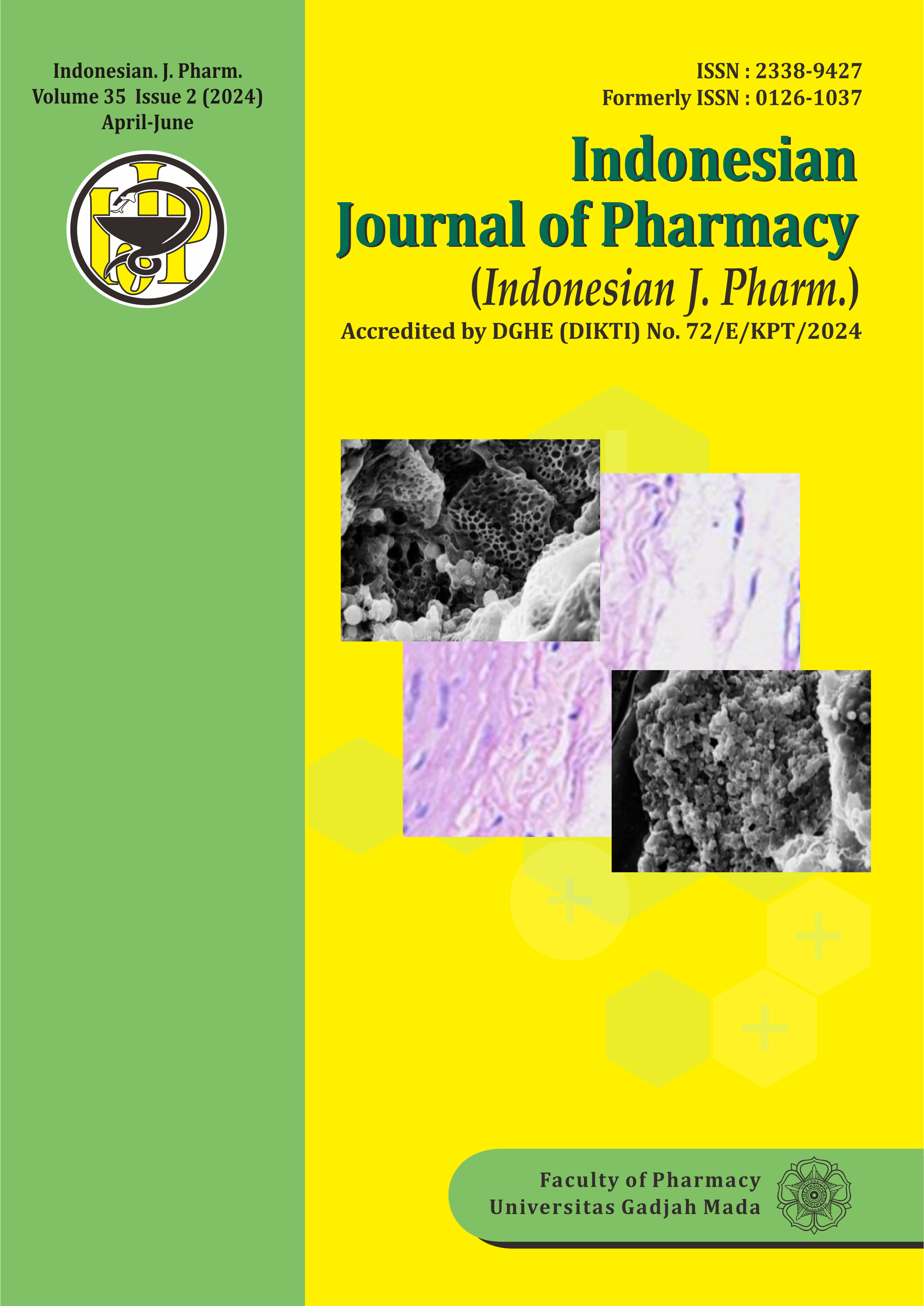Formulation and Evaluation of Luliconazole nanosponge gel using Experimental design
Abstract
Different approaches are being in the practice for the topical application of antifungal drugs, although in a few cases, they have been found less efficient because of their poor cutaneous availability and permeability. Luliconazole (LUL) is one of the antifungal medications that is being used for the treatment of various superficial infections. The poor permeability of LUL is regarded to be a factor for its reduced efficacy. Hence, the current study aimed to develop a nanosponge hydrogel that would improve dermal availability and permeability. A set of nanosponge formulations (L1-L18) were designed with the help of central composite design (Design Expert 13, state ease Inc., Minneapolis, MN, USA). L1-L18 was prepared by using the emulsion solvent evaporation technique. The nanosponges were characterized for drug-excipient compatibility (FTIR, P-XRD, and DSC), and particle size, polydispersibility index, zeta potential, entrapment efficiency (EE), and in vitro drug release; further optimized. The optimized nanosponge formulation (L18) was taken to produce six hydrogels (LF1-LF6) of LUL by varied proportions of the gelling agent. In this process, initially, the gel was constituted with Carbopol 934/ sodium CMC/HPMC. Later, attained hydrogel texture was evaluated for its viscosity, swelling, and membrane permeability, followed by in vitro drug release, and antifungal efficacy study. The nanosponge formulations (L1-L17) had an average particle size of 109±0.45 to 386±0.34 nm, entrapment efficiency of 35.45±0.46- 89.65±0.37 % with 84.67±0.54 -99.65±0.48 % of drug release for 8 h. The formulation L18 was predicted with better responses in particle size, EE, and drug release i.e., 378±0.25 nm, 84.65±0.45%, and of 96.18±0.54%, respectively for 8 h. Out of six formulated nanosponge gels (LF1-LF6), LF2 showed an optimal viscosity (25.69 ±0.45 pa.S), pH (6.87±0.56) and % drug release (80.65 ±0.64%) in 8 h. Drug release was governed by non-fickian diffusion mechanisms and zero-order. Developed nanosponge hydrogel was found as stable and had a high rate of permeation with better retention which can be effective enough in topical applications.
References
Aggarwal, G., & Nagpal M.(2016). Development and comparison of nanosponge and noisome-based gel for the topical delivery of Tazarotene.Pharmaceutical Nanotechnology .4:213-28.DOI:10.2174/2211738504666160804154213.
Alhakamy, NA., Md, S., Alam, MS., Shaik, R., Ahmad, J., Ahmad A. (2021). Development, optimization, and evaluation of luliconazole nano-emulgel for the treatment of fungal infection. Journal of Chemistry. 2021: 1–13.DOI.org/10.1155/2021/4942659
Amer, RI., El-Osaily, GH., & Gad, SS.(2020). Design and optimization of topical terbinafine hydrochloride nanosponges: Application of full factorial design, in vitro and in vivo evaluation. Journal of Advanced Pharmaceutical Technology and Research 11: 13-9.DOI: 10.4103/japtr.JAPTR_85_19.
Aydar, AY. (2018). Utilization of response surface methodology in optimization of extraction of plant materials. In: Silva, V. Editor. Statistical Approaches With Emphasis On Design Of Experiments Applied To Chemical Processes. 10:157-69.
Bansal, M., and Jamil, S.2018. Micellar microparticles: a novel approach to topical drug delivery system. International Journal of Pharmaceutics.10(5):1-5.DOI:10.22159/ijap.2018v10i5.27506
Clogston, JD., & Patri, AK (2011). Zeta Potential Measurement. In: McNeil S. (eds) Characterization of Nanoparticles Intended for Drug Delivery. Methods in Molecular Biology. 697: 63-70. DOI: 10.1007/978-1-60327-198-1_6.
Gill, P., Moghadam, T., & Ranjbar B.,(2010). Differential scanning calorimetry techniques applications in biology and nanoscience. Journal of Biomolecular Technology. 21(4):167-193.PMCID: PMC2977967.
Haranath, C., Ahad, HA., Bhargav, E., & Pradeep Kumar, B. (2021). Central composite design aided formulation development and optimization of clarithromycin extended-release tablets. Indian Journal of Pharmaceutical Education and Research. 55: 395-406. DOI:10.5530/ijper.55.2.77
Imran, K., Tadwee, Sourabh, G., & Prashant, G.2012. Advances in topical drug delivery system: A Review. International Journal of Pharmaceutical Research and Allied Sciences. 1(1):14-23.
Iriventi, P., Gupta, NV., Osmani, R., & Balamuralidhara, V.(2020). Design & development of nanosponge-loaded topical gel of curcumin and caffeine mixture for augmented treatment of psoriasis. Daru: Journal of Pharmacy. 28(2): 489-506.DOI: 10.1007/s40199-020-00352-x.
Kasar, P., Kale, K., & Phadtare, D. (2018). Formulation and evaluation of topical antifungal gel containing itraconazole. International Journal of Current Pharmaceutical research.10(4):71-74.DOI.org:10.22159/ijcpr.2018v10i4.28470.
Kumar, M., Shanthi, N., Mahato, A., Soni, S., & Rajinikanth P.(2019). Preparation of luliconazole nanocrystals loaded hydrogel for improvement of dissolution and antifungal activity. Heliyon. 5(5): e01688.DOI: 10.1016/j.heliyon.2019.e01688.
Malkiet, K., & Manju K.(2020). Formulation and characterization of topical gel of cinnamon oil nanosponge carriers. Proceedings of International Conference on Drug Discovery (ICDD).
Mihailiasa, M., Caldera, F., Peila, R., Ferry, A., Trotta, F., & Li J.(2016). Preparation of functionalized cotton fabrics by means of melatonin loaded β-cyclodextrin nanosponges, Carbohydrate Polymers.142:24-30.DOI:10.1016/j.carbpol.2016.01.024
Muqtader, Md. , Fatima, F. , Khalid, Md., Osman, El., abul, M., Mohmmed, F., Ahmed, A.,& Mohammad, JA. (2021). Formulation and in vitro evaluation of topical nanosponge-based gel containing butenafine for the treatment of fungal skin infection. Saudi Pharmaceutical Journal. 29(5):467-477.DOI:10.1016/j.jsps.2021.04.010.
Nasir, A., Kousar, P., Amjad, H., Sumera, L., Shaiq, Uz., Parvaiz, A S., & Muhammad, A . (2019). Nanosponge-based hydrogel preparation of fluconazole for improved topical delivery. Tropical Journal of Pharmaceutical Research. 18 (2): 215-22. DOI:10.4314/tjpr.v18i2.1
Preetha, D., Prachi, K., Chirom, A., Arun R. (2013). Synthesis and characterization of silver nanoparticles using cannonball leaves and their cytotoxic activity against MCF-7 Cell Line. Journal of Nanotechnology. 2013: 1-5.
DOI:10.1155/2013/598328.
Rasmussen, MK., Pedersen, JN., & MarieR.(2020). Size and surface charge characterization of nanoparticles with a salt gradient. Nature Communication. 11:1-8.








